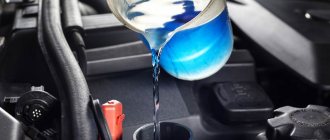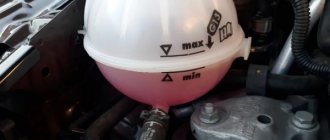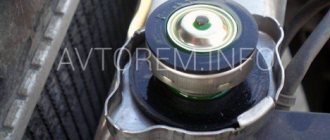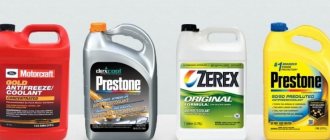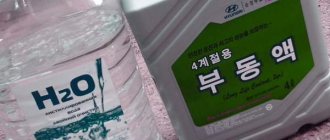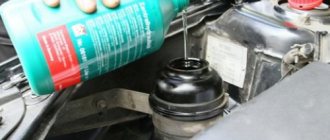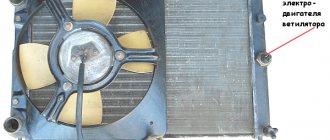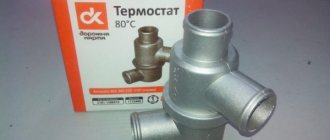Answers (2)
On the expansion tank you can see a sticker with the inscription Sintec antifreeze. Usually red/pink.
So it is recommended to add SINTEC LUX G12 - red carboxylate, ready for use.
If you change it completely with flushing, you can also fill it with another coolant, for example Felix G12+.
Sintec antifreeze in Lada Kalina Cross
I have a Lada Kalina 2014. I took the car from a relative, but I know that he hardly drove it, and the odometer proves it - 20 thousand km. But still, 5 years is already the time when it’s time to change all the fluids. Actually, I decided to spend the weekend getting the car in shape. Now the problem is that there is no way to choose antifreeze. Are there any recommendations on this matter?
Well, listen, look at the color of the liquid poured into the tank and pour in the same. Moreover, the car is 14 years old and probably nothing has been changed in it
How do you imagine this? Let's say red antifreeze is poured into it, accordingly, in your opinion, when a person comes to the store, he should take any red one and pour it calmly? That is, you are not confused by the fact that antifreezes can be completely different in composition and be identical in color? In short, you are spreading some kind of heresy. Antifreeze cannot be selected by color at all, because it is created by a dye and does not affect the properties of the coolant itself. The only correct way to select a coolant is with the approval of the car manufacturer. We took the canister, saw the approval for your car, and filled it up. That’s it, there’s no point in inventing a dependence on flowers and blablabla. Well, as for the selection specifically for viburnum, the question is not difficult. After all, it is known that they are filled with coolstream nrc at the factory, so take it. The cooler has been showing its best side for many years. And bloggers recommend it for a reason. From my own experience I can say that it’s been 4 years since I filled it up and I’m driving smoothly.
Yes, I’ve heard a lot about coolstream and it gets good reviews. I'll take it. Thanks for the advice
FakeHeader
Comments 21
Then my friend told me. He bought a car, and the coolant tank was filled with such trash that you couldn’t tell the original color. According to the manual, opinions varied, the services said different things. He spat and bought a Syntekov multifreeze. I’m very pleased - the cooler holds the temperature, works perfectly, and there are no problems with selection, since multifreeze can be poured into any engine. Following his example, I also switched to cartoons - I’m happy)))
I read forums and different reviews, they say you can even mix it. Well, if, for example, the flooded cooler has gone somewhere, but there is no way to buy it.
Tomorrow I’m going to pick up my first car, a Lada Granta 2016. It has one owner, mileage is 50,000. In general, it's a piece of cake, so to speak. I am writing here because I need advice. Is it worth changing the coolant? Because, as I understand it, the warranty on it has expired
Yes, it's worth changing the coolant. I think you can easily choose the color
Oh, again they advise on color. What kind of nonsense is this anyway?! Do you even believe in your own words?! The color of antifreeze is created by a dye that is added to antifreeze to make it easier to buy. Okay, for especially tight ones... ANTIFREEZE IS NOT SELECTED BY COLOR Remember, antifreeze must be selected only with the approval of the car manufacturer! Exclusively In general, for grants there is nothing better than its original antifreeze. The original for her is coolstream nrc. Excellent coolant, I've been using it for 4 years already. I took it because it obviously has approval, and besides this, it has additives that are ideal for such engines.
We select consumable fluids for Kalina-2. Factory recommendations
A car manufacturing plant always recommends the use of fuels and lubricants of certain brands. As for gasoline, Kalina-2 owners are advised to refuel their cars with the following brand of fuel: “Premium Euro-95” (GOST R-51866). In fact, any gasoline with an octane rating of 95 will do, but the instructions state that the fuel must not contain metal additives (lead, iron, manganese). Such additives are the basis of anti-knock mixtures.
- All motor oils recommended for use
- Manual transmission oil
- Washer fluid, antifreeze and the rest
All motor oils recommended for use
Engine oil is usually replaced along with a paper filter. This consumes 2900 ml of fluid (for versions with automatic transmission – 4100 ml). The intervals between replacements are indicated in the service book. Recommended materials for use:
| Brand | Viscosity SAE | Quality |
| Lukoil LUX | 15W40 | SL/CF (B5/D3) |
| Lukoil LUX semi-synthetics | 5W30, 5W40, 10W40 | SL/CF (B5/D3) |
| Lukoil LUX synthetic | 5W30, 5W40 | SN/CF (B6/D3) |
| Rosneft MAXIMUM (Angarsk, Novokuibyshevsk) | 5W40, 10W40 | SL/CF (B5/D3) |
| Rosneft PREMIUM (Angarsk) | 5W40 | SM/CF (B6/D3) |
| TNK MAGNUM SUPER | 5W30, 5W40, 10W40, 15W40, 15W50 | SL/SJ/CF (B5/D3) |
| Gazpromneft PREMIUM | 10W40 | SL/CF (B5/D3) |
| G-ENERGY S SYNTH, F SYNTH | 5W40, 10W40 | SL/CF (B5/D3) |
| G-ENERGY EXPERT L | 5W30, 5W40, 10W40 | SL/CF (B5/D3) |
| GT TURBO SM (Hanval INC) | 10W40 | SM (B5) |
| ESSO ULTRA | 10W40 | SL/SJ/CF (B5/D3) |
| MOBIL 1 ESP FORMULA | 5W30 | SN/SM/CF (B6/D3) |
| MOBIL 1 NEW LIFE, PEAK LIFE, SUPER 3000 X1 | 0W40, 5W40, 10W40, 5W50 | SN/SM/SL/SJ/CF (B6/D3) |
| MOBIL SUPER 2000 X1 | 0W40, 5W40, 10W40, 5W50 | SL/SJ/CF (B5/D3) |
| SHELL HELIX PLUS | 5W40, 10W40 | SL/CF (B5/D3) |
| SHELL HELIX ULTRA, HX7, HX8, PLUS EXTRA | 5W40, 10W40 | SM/CF (B6/D3) |
| ZIC A PLUS | 5W30, 10W30, 10W40 | SL (B5) |
To narrow the range of choices, be guided by the climatic conditions in which the car will be used. It is recommended to determine the viscosity class based on air temperature:
| lower limit | Viscosity grade | Upper limit |
| –35 and below | 0W40 | +30 |
| –30 | 5W30 | +25 |
| –30 | 5W40 | +35 |
| –25 | 10W30 | +25 |
| –25 | 10W40 | +35 |
| –20 | 15W40 | +45 |
| –20 | 20W50 | 45 and above |
It is recommended to change the oil at a service station (service station). , however, the owner himself can add liquid to the tank.
Adding oil to the expansion tank
The oil level is controlled as follows: when the engine is turned off, unscrew the diagnostic dipstick located near the cylinder head cover between the third and second cylinders. A secondary check is carried out no earlier than after 3–5 minutes. after topping up.
Remember that motor oils of different brands cannot be mixed. The same applies to materials made on different bases (synthetic/semi-synthetic). Be careful when choosing.
The factory usually fills it with semi-synthetic material with a viscosity of 5W30 produced by Rosneft OJSC. Check the information by opening the service book.
Manual transmission oil
Transmission oils, just like motor oils, are classified according to quality level. According to API designations, all performance properties are characterized by one number (from 1 to 6). The following consumables are suitable for the manual transmission of Kalina-2 cars:
| Brand | Viscosity SAE | API class |
| Lukoil TM-4 transmission | 75W80, 75W85, 75W90, 80W85, 80W90 | GL-4 |
| Rosneft KINETIC (Angarsk, Novokuibyshevsk) | 80W85 | GL-4 |
| Rosneft KINETIC (Novokuibyshevsk) | 75W90 | GL-4/5 |
| Tatneft TRANSLUX TM4-12 | 75W85 | GL-4 |
| TNK TRANS KP | 80W85 | GL-4 |
| TNK TRANS KP SUPER | 75W90 | GL-4 |
| G-BOX EXPERT GL-4 | 75W90, 80W85 | GL-4 |
| Gazpromneft GL-4 | 80W85, 80W90 | GL-4 |
| SHELL SPIRAX S5 ATE | 75W90 | GL-4/5 |
In an automatic transmission, the oil cannot be changed. When changing manual transmission oil, it is preferable to use material with a viscosity of 75W85, 75W90.
How to add transmission oil
By unscrewing the dipstick plug from the gearbox housing, you can check the transmission oil level. Topping up is done through the hole in the casing in small portions.
The main thing is that the dipstick plug should always be screwed in as far as possible. The volume of transmission fluid in a manual transmission is 2200 ml, but, according to reviews, it is about 3 liters. The material used is from the factory manufactured (see table above).
Washer fluid, antifreeze and the rest
The glass washer tank, the volume of which in Kalina-2 is 5 liters, is recommended to be filled with a suitable liquid:
| Brand | Manufacturer |
| REVIEW-E | LLC "ASD" (Tolyatti) |
| REVIEW | JSC "Orsknefteorgsintez" (Orsk) |
| SPARK | NPP "Makromer" (Vladimir) |
| NET MILE 40 | Tosol-Sintez LLC (Dzerzhinsk) |
The brake system filler can be ROSDOT fluid, produced by TC Tosol-Sintez LLC, or KAPROS-DOT produced by Sibur-Neftekhim. These materials are produced in the city of Dzerzhinsk. The volume of brake fluid to be replaced will be 0.45 liters.
New design of ROSDOT labels
The volume of coolant in the engine cooling system is 7.84 liters. When replacing, it is recommended to use the following materials:
| Brand | Manufacturer |
| FELIX CARBOX, TOSOL-TS FELIX | Tosol-Sintez LLC (Dzerzhinsk) |
| Cool Stream Standard, G-Energy Antifreeze, Cool Stream Premium | JSC "Technoform" (Klimovsk) |
| ANTIFREEZE SINTEC | CJSC "Obninskorgsintez" (Obninsk) |
Compatible coolants are those whose color matches. If this requirement is violated, refilling is not performed. At the same time, materials painted in the following two colors may be compatible: blue, green.
What antifreeze does AvtoVAZ recommend?
For all VAZ engines (Lada Granta, Kalina, Priora, Niva 4x4), the manufacturer’s recommendations are the same (data from books on the operation, maintenance and repair of Lada cars):
- Antifreeze G-48;
- Cool Steam Standard;
- Cool Steam Premium;
- TS-Felix;
- Felix Carbox;
- SINTEC (for example, “Antifreeze SINTEC” TU 2422-047-51140047-2007);
- Long Life;
- G-Energy Antefreexe.
For K4M and K7M power units that are installed on Lada Largus, the manufacturer recommends GLACOEL RX antifreeze (type D). For Lada Vesta and XRAY, it is recommended to use Type D antifreeze based on a mixture of water and ethylene glycol.
AvtoVAZ's response
: coolant in the VAZ 21179 engine cooling system - Antifreeze Sintec LUX G12 (Sintec ANTIFREEZLUX G12).
Coolstream NRC in yellow is also used.
Tips and tricks
If it is discovered that the cap on the designated reservoir is not sealing properly, it should be replaced immediately after replacing the coolant.
Product options:
- cover with code “2108 2108-1311065” in the “Autodevice” version; cost not less than 150 rubles;
- a product with the article number “2108 LUZAR LL 0108” at a price of about 100 rubles;
- lid made by "Chistopol" with code "2108-1311065" at a cost of 70 rubles.
Replacing the coolant in the Lada Kalina car is complete, and now check the circuit for leaks. If it is present, then replace the clamps that hold the joint sections of the pipes.
Antifreeze level Lada Vesta
The Lada Vesta antifreeze level must be monitored using marks on the expansion tank under the hood of the car. It is installed on the passenger side in the far corner of the engine compartment of the car and has the shape of a ball.
The tank indicates the minimum and maximum marks, as well as the type of liquid being filled. In our case it is G12. If there are no leaks in the cooling system and the engine has cooled down, the coolant level should be between the MIN and MAX marks. When the engine is warm, antifreeze expands and can reach its maximum level.
If the Lada Vesta antifreeze runs out and the level constantly drops, then you need to add coolant to the required amount and contact a specialized service. Factory antifreeze Lada Vesta has a special fluorescent additive that glows under ultraviolet light. Thanks to this, you can quickly determine the location of the coolant leak.
Which company is better
“Behind the Wheel” tested coolants in November 2021. Test results:
As far as I know, red-orange antifreezes are based on propylene glycol, and blue-green and yellow colors are based on ethylene glycol. On their own, propylene glycol, ethylene glycol and water mix quite well, but I have heard that red antifreeze has a new additive package that is more durable and environmentally friendly, but is not compatible with the old one. So, if you add a little red to the red one, nothing will happen. I know different situations, even when people on the highway were forced to pour distillate in order to get there, or pour another into a mixture of one color
The most important thing is not to interfere with the color scheme, for example, do not add blue to orange
Is it possible to mix antifreeze?
Is it possible to mix antifreeze from different manufacturers? The operating manual for the Lada car states: “The use of mixtures of coolants of different brands is not allowed.”
Is it possible to mix antifreeze of different colors, but from the same manufacturer? There is no definite answer, because... Some manufacturers color the coolant “to taste,” while others add color based on the chemical composition or additives. According to statistics, about 85% of motorists do not mix antifreeze of different colors. At the same time, 64% believe that if you mix antifreeze of different colors, nothing bad will happen. You can view the survey and take part in it here.
The book on operation, maintenance and repair of the Lada Vesta car states:
Frequently asked questions
Antifreeze or antifreeze?
Video: Antifreeze or antifreeze: which is better to use and pour into your car? Just something complicated
Among motorists, the question often arises as to what is better - antifreeze or antifreeze? In general, there is no difference, since both names mean car coolant. Antifreeze is a domestically produced liquid, and it is counterfeited much more often.
Is color scheme important? And is it possible to mix liquids of different colors?
It is worth noting that antifreeze and antifreeze themselves are colorless, and the choice of shade depends entirely on the manufacturer. The dye itself is added in an extremely small amount, so it has no effect on the performance characteristics of the liquid. This means that you should not mix different liquids. The exception is the presence on the label of information about the approval of mixing this antifreeze with others.
When to change antifreeze?
Many automakers fill in antifreeze for the entire service life, which is indicated in the manual for the model. Although companies give their own recommendations on timing:
- Volkswagen – indefinitely;
- General Motors - indefinitely;
- Renault – indefinitely;
- Mitsubishi – 4 years;
- Ford – 240,000 km or 10 years;
- Mercedes-Benz – 5 years;
- AvtoVAZ - 75,000 km;
- Mazda – indefinitely;
- Daimler – 15 years;
- BMW – 4 years.
What antifreeze to choose for VAZ (Lada) Granta?
Last month, PartReview users preferred SINTEC. 60% of positive votes belong to this manufacturer.
FELIX antifreeze took second place – 40%.
In the general rating of antifreeze, which takes into account the opinions of owners of different brands and models of cars, these brands occupy the following positions:
- SINTEC received 6th place, PR score – 88. Data from 143 reviews and 447 votes are taken into account.
- FELIX took 16th place, with a PR score of 70. Based on 143 reviews and 457 votes.
How to change coolant
You will need : remove the crankcase protection (if necessary), a 13 mm spanner, a screwdriver, a clean wiping cloth, an empty container, and new antifreeze.
Before draining antifreeze from Granta , you should first wait until the engine cools down, then:
- Remove the cap from the expansion tank.
- Place an empty container under the engine and remove the drain plug on the cylinder block.
- For VAZ-11183, VAZ-21116 and VAZ-11186 engines, to access the drain plug, you may have to remove the ignition coil along with the bracket.
- Wait until the antifreeze has completely drained.
- Place a container under the engine radiator and remove the drain plug on the radiator.
- Wait until the coolant has completely drained from the cooling system.
- Screw in the drain plug on the radiator, replacing the rubber O-ring if necessary.
- Tighten the plug on the cylinder block.
We pour new antifreeze into the Granta cooling system until its level reaches 25-30mm. below the “MAX” mark on the wall of the expansion tank. Then tighten the tank cap. Start the engine and let it warm up to operating temperature (before turning on the fan). Then turn off the engine and, if necessary, add fluid to the “MAX” mark. Check the fluid level after a few days.
After replacing the antifreeze, monitor the coolant temperature using the instrument cluster.
If the overheating indicator lights up (No. 7) and the radiator fan does not turn on, turn on the heater (stove) and check what kind of air is coming from the air ducts. If the air is hot, there may be a malfunction in the fan operating system; if it is cold, it means that an air lock has formed in the cooling system .
2279-4-9a-02d
We unscrew the plug as shown above and drain the coolant from the cylinder block.
We unscrew the plug as shown above and drain the coolant from the cylinder block.
We unscrew the plug as shown above and drain the coolant from the cylinder block.
We tighten the drain plugs of the radiator and cylinder block. The connection between the plug and the cylinder block uses a conical thread that does not require additional sealing. Tighten the drain plug of the cylinder block to a torque of 25–30 Nm. Pour liquid into the engine cooling system through the expansion tank until it is full. Let's start the engine. With the engine running, vigorously compress all the hoses of the cooling system several times in turn - this will help the fluid fill the system and displace air from it. As the coolant level in the expansion tank drops, bring it to normal and screw on the tank cap. When the engine warms up, the outlet (lower) radiator hose should be cold for some time, and then quickly heat up, which will indicate the beginning of fluid circulation in a large circle. After waiting for the cooling system fan to turn on, stop the engine. After the engine has cooled, check the coolant level again and, if necessary, replenish the system.
[14 Lada Granta maintenance operations that will help you save]
[How to save money on scheduled maintenance of Lada Granta] [Maintenance of Lada Granta at 2.5 thousand km] [Maintenance of Lada Granta at 15,000 and 105,000 km] [Maintenance of Lada Granta at 30,000 and 60,000 km ] [Maintenance of Lada Granta at 45 thousand km] [Maintenance of Lada Granta at 75 thousand km] [Maintenance of Lada Granta at 90 thousand km] [Carrying out maintenance yourself - general recommendations] [Safety rules for doing it yourself carrying out maintenance] [Tools required for maintenance of Lada Granta] [Lamps used in the Lada Granta car]
Replace coolant Lada Granta
Replacing antifreeze Lada Granta
Before draining the antifreeze from the Granta, you should first wait until the engine cools down, then:
After replacing the antifreeze, monitor the coolant temperature using the instrument cluster.
- Allow the engine to cool.
- Unscrew the expansion tank cap.
- Start the engine and let it run for 3-5 minutes.
- Close the tank lid.
- To better fill the system without air locks, periodically squeeze the radiator hoses by hand.
Similar materials
It is more convenient to replace the coolant when the car is installed on an inspection ditch or overpass.
If the engine is hot, you need to let it cool and then relieve excess pressure in the cooling system by unscrewing the expansion tank cap.
To access the drain holes from below, you must remove the middle mudguard of the engine compartment.
Dirt guards of the engine compartment of a car with a manual transmission and their fastening elements (view from below the car): 1 - three screws for the “8” turnkey fastening of the middle shield to the right shield; 2 — right shield; 3 - middle shield; 4 — four self-tapping screws “8” for fastening the middle shield to the lower cross member of the radiator frame; 5 — two self-tapping screws “8” for fastening the middle shield to the left shield; 6 — left shield; 7 - two “10” bolts for fastening the middle shield to the body side members
After unscrewing all the indicated bolts and screws, remove the middle mudguard of the engine compartment.
Unscrew the plastic drain plug of the radiator tank...
...and drain the coolant into a container.
The connection is sealed with a rubber ring.
To drain the coolant from the cooling jacket of an 8-valve engine equipped with a traction drive gearbox, place a container under the drain hole located on the front side of the cylinder block below the ignition coil.
Using a 13mm socket, unscrew the drain plug of the cylinder block.
Drain the liquid into a container.
On a vehicle with a 16-valve engine equipped with a cable-driven gearbox, access to the drain hole in the cylinder block is prevented by the starter. In addition, the leaking liquid will inevitably get inside the starter.
Therefore, the starter needs to be removed. Disconnect the wire terminal from the negative terminal of the battery. By pressing the latch of the wire block, disconnect the block from the traction relay connector. Remove the protective cap from the nut securing the tip of the wire connected to the positive cable of the battery.
What you need to know when adding antifreeze
It is worth recalling this important rule: you cannot mix refrigerants with different characteristics. When mixing such a cocktail, as a rule, a precipitate forms, which will not evaporate in the air and will not disappear, but will gradually settle on the thin radiator tubes and other parts of the SOD and coke in the delicate parts and mechanisms of the system
That is why manufacturers recommend the use of those antifreezes that are suitable for your car, and those that are approved and initially fill the car’s cooling system.
You should not focus on the color of the coolant, it will only confuse you completely. The color of antifreeze does not depend on its quality and composition. Sometimes liquids of the same shade can be completely different in chemical composition, and vice versa, multi-colored antifreezes will be compatible in structure, additives, and base
Therefore, when purchasing, you should pay attention not to the color of the coolant, but to its composition and main characteristics.
Cooling system Lada Granta (VAZ 2190)
The engine cooling system is liquid, closed type with forced circulation of coolant and an expansion tank.
| Temperature at which the thermostat valve begins to open, *C | 85-89 |
| Full opening temperature of the thermostat valve, *C | 102 |
| Opening pressure of the outlet valve of the expansion tank plug, kPa (bar) | 110-150 (1,1-1,5) |
| Opening pressure of the inlet valve of the expansion tank plug, kPa (bar) | 3-13 (0,1) |
| Coolant temperature in a warm engine at an ambient temperature of 20-30 *C and a fully loaded vehicle moving at a constant speed of 80 km/h, no more, *C | |
| Volume of liquid in the engine cooling system, l | 7.84 |
| Coolant (mixing liquids of different brands is not allowed) | Cool Stream Standard; Cool Stream Premium; Antifreeze-TS Felix, Felix Carbox-40 |
| Name of units and parts | Thread | Tightening torque, Nm (kgf-m) |
| Coolant pump mounting bolts | M6 | 7,6-8,0 (0,8-0,8) |
| Thermostat mounting nuts | M6 | 16.0-22,6(1,6-2,3) |
| Bolts securing the cooling system pipe flange to the cylinder block | M6 | 4,2-5,2 (0,4-0,5) |
Cooling system: 1 — coolant drain hose from the heater radiator; 2 — hose for supplying coolant to the heater radiator; 3 – hose for draining fluid from the engine radiator; 4 – expansion tank hose; 5 – expansion tank; 6 – steam exhaust hose of the engine radiator; 7 – thermostat; 8 – hose for supplying fluid to the engine radiator; 9 – electric radiator fan; 10 – engine radiator; 11 – radiator drain plug; 12 – coolant pump; 13 – supply pipe of the coolant pump
The engine cooling system uses special fluids based on a mixture of water and ethylene glycol. They have a low freezing point and a high boiling point. In addition, thanks to the complex of added additives, the coolant prevents corrosion of the channel walls, does not foam, and extends the service life of the coolant pump seal.
Fluid circulation in the system is ensured by a centrifugal pump installed in the cylinder block. The pump is driven by a timing belt.
The cooling system consists of two so-called circulation circles. The small circle does not include the engine radiator, and the fluid washes only the cylinder block and cylinder head, and also flows through the heater core. The heater radiator is built into the engine cooling system and is designed to heat the passenger compartment by circulating hot coolant through it. When moving in a large circle, the coolant passes through the engine radiator, where it is cooled by the incoming air flow. The thermostat controls the direction of fluid flow in the engine cooling system.
If the air flow is not intense enough, the radiator is cooled by an electric fan. It is installed behind the engine radiator and is activated by a signal from the electronic engine control unit. An additional resistor is built into the power supply circuit of the fan motor.
To compensate for the thermal expansion of the liquid, an expansion tank is installed in the cooling system. The tank plug contains inlet and outlet safety valves, which allows you to maintain optimal pressure in the system when the liquid is heated, and also compensate for the vacuum when it cools.
